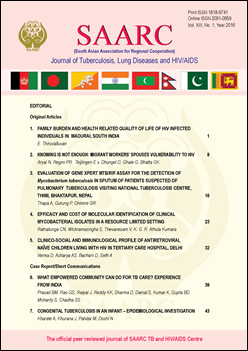Evaluation of Gene Xpert Mtb/Rif Assay for the Detection of Mycobacterium Tuberculosis in Sputum of Patients Suspected of Pulmonary Tuberculosis Visiting National Tuberculosis Centre, Thimi, Bhaktapur, Nepal
DOI:
https://doi.org/10.3126/saarctb.v13i1.16924Keywords:
Gene Xpert MTB/RIF Assay, M. tuberculosis, Pulmonary TuberculosisAbstract
Introduction: Tuberculosis (TB) is one of the most deadly and common major infectious diseases in developing countries. Rapid and accurate diagnosis of tuberculosis is indispensable to adequately manage the disease and control its transmission. The objective of this study was to evaluate Gene Xpert MTB/RIF Assay for detection of M. tuberculosis in sputum of patients suspected of pulmonary tuberculosis and its comparison with traditional conventional methods.
Methodology: A total of 138 patients sputum samples were collected and processed. Gene Xpert MTB/ RIF Assay, culture method and smear microscopy were performed under standard guideline inside biosafety cabinet class II. Data were reported, structured and analyzed using SPSS version 16.00. Study was carried out from June to November 2014.
Results: Assay detected M. tuberculosis in 37 (26.81%) samples out of total 138. Of these 37, 10 and 3 were resistance and indeterminate to rifampicin respectively. Culture, Ziehl-Neelsen staining and Auramine staining were positive in 43 (31.16%), 18 (13.04%) and 24 (17.39%) samples respectively. Sensitivity, specificity, Positive predictive value and Negative predictive value of Assay were 76.74%, 95.79%, 89.19% and 90.09% respectively with reference to gold standard culture method.
Conclusions: Assay was found rapid in direct detec tion of Mycobacterium tuberculosis in sputum sample and was also found more sensitive than both Ziehl-Neelsen staining and Auramine staining and especially showed good promise in diagnosis of smear negative specimens.
SAARC J TUBER LUNG DIS HIV/AIDS, 2016; XIII(1), page: 16-22
Downloads
Downloads
Published
How to Cite
Issue
Section
License
Copyright © SAARC Tuberculosis and HIV/AIDS Centre (STAC), all rights reserved, no part of this publication may be reproduced, stored in a retrieval system or transmitted in any form or by any means without prior permission of the STAC.




